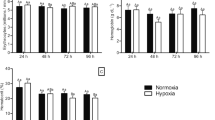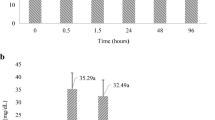Abstract
The extensive in vivo conversion of haemoglobin to the carbon monoxide derivative has no discernible effect on the survival of the red-blooded Antarctic fishPagothenia bernacchii. Analysis of caudally sampled blood of cannulated specimens revealed that reconversion of carbon-monoxy haemoglobin to oxyhaemoglobin was complete within 48 hours. Thus, under stress-free conditions, haemoglobin is not necessary for survival ofP. bernacchii. Red-blooded Antarctic fishes can carry oxygen necessary for routine delivery dissolved in plasma, in a similar way to the haemoglobinless Channichthyidae, although they lack the morphological and physiological adaptations which allow the latter to prosper without any haemoglobin.
Similar content being viewed by others
References
Everson, I., and Ralph, R., Br. Antarct. Surv. Bull.15 (1968) 59.
Hureau, J.-C., Petit, D., Fine, J. M., and Marneux, M., in: Adaptations within Antarctic Ecosystems, pp. 459–477. Ed. G. A. Llano. Smithsonian Institution, Washington 1977.
Wells, R. M. G., Ashby, M. D., Duncan, S. J., and Macdonald, J. A., J. Fish Biol.17 (1980) 517.
Ruud, J. T., Nature173 (1954) 848.
Kennett, J. P., J. geophys. Res.82 (1977) 3843.
Eastman, J. T., and Grande, L., in: Origins and Evolution of the Antarctic Biota, pp. 241–252. Ed. J. A. Crame. Geological Society of London, London 1989.
Wells, R. M. G., Macdonald, J. A., and di Prisco, G., J. Fish Biol.36 (1990) 595.
Andriashev, A. P., in: Proc. 5th Congr. Eur. Ichthyol., Stockholm, pp. 357–372. Eds S. O. Kullander and B. Fernholm. Swedish Museum of Natural History, Stockholm 1987.
Antonini, E., and Brunori, M., Hemoglobin and Myoglobin. North Holland, Amsterdam 1971.
Hemmingsen, E. A., and Douglas, E. L., Comp. Biochem. Physiol.33 (1970) 733.
Hemmingsen, E. A., and Douglas, E. L., in: Adaptations within Antarctic Ecosystems, pp. 479–487. Ed. G. A. Llano. Smithsonian Institution, Washington 1977.
Holeton, G. F., Comp. Biochem. Physiol.34 (1970) 457.
Macdonald, J. A., Montgomery, J. C., and Wells, R. M. G., Adv. mar. Biol.24 (1987) 321.
Wells, R. M. G., Polar Biol.5 (1986) 175.
di Prisco, G., and D'Avino, R., Antarctic Science1 (1989) 119.
Riggs, A., in: Fish Physiology, vol. 4, pp. 209–252. Eds W. S. Hoar and D. J. Randall, Academic Press, New York 1970.
Brunori, M., Curr. Top. cell. Reg.9 (1975) 1.
Nicloux, M., C. r. Séanc. Soc. Biol., Paris89 (1923) 1328.
Ryback, B., Nature185 (1960) 777.
Stolk, A., Nature185 (1960) 625.
Anthony, E. H., J. exp. Biol.38 (1961) 109.
Cameron, J. N., and Wohlschlag, D. E., J. exp. Biol.50 (1969) 307.
Fox, H. M., Nature173 (1954) 850.
Author information
Authors and Affiliations
Rights and permissions
About this article
Cite this article
di Prisco, G., Macdonald, J.A. & Brunori, M. Antarctic fishes survive exposure to carbon monoxide. Experientia 48, 473–475 (1992). https://doi.org/10.1007/BF01928166
Received:
Accepted:
Published:
Issue Date:
DOI: https://doi.org/10.1007/BF01928166




